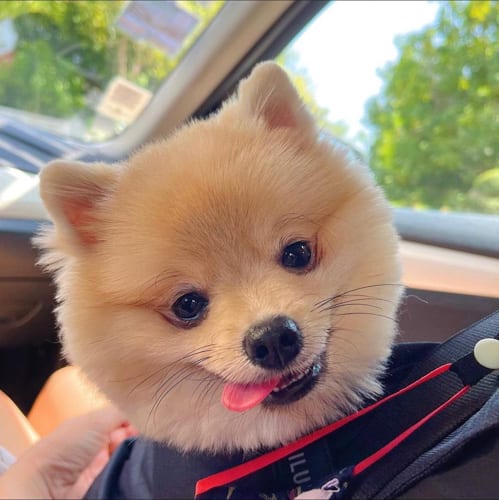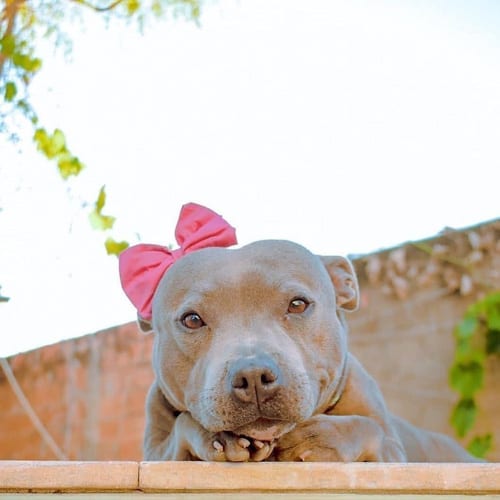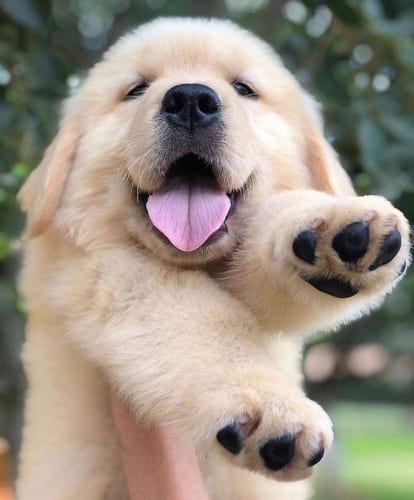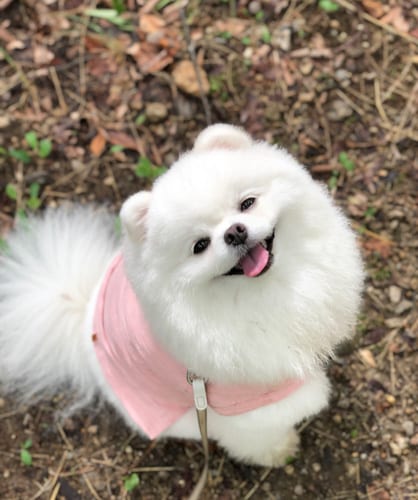As dog lovers, we imagine all sorts of conversations with our beloved canine friends.
We play and talk to them in our cute voice as if they comprehend every piece of what’s been said.
Yet, it is obvious that they understand our intention. Dogs can recognize our emotions.
It is demonstrated when they respond to our commands even without treats. They also seem to mimic our gestures.
They deeply observe us and adapt our behavior little by little with all their love. It is also said that sometimes, dogs and owners grow to look alike.
Do Dogs Smile?

Don’t we get ever so excited to be home and be greeted by our buddy?
There they are, tippy tapping their paws while waiting for you to enter the gate and vigorously wagging tails.
Generous licks on your face. Enthusiastic jumps. Belly waiting to be rubbed.
And perhaps, a smile?
We are all familiar that the equivalent of smiling in dogs is wagging of their tail. For owners, it’s like a happy flag.
A friendly wag is when they wiggle their hips; the tail whips freely from side to side. An excited wag is a fast whip or spin that seems to vibrate.
But there is, in fact, another expression that’s close to a human smile. It’s when they slightly open their mouth, and tongue lolls over teeth. Their snout may be curved a bit upward.
Do Dogs Laugh?

Dogs also laugh, and we can observe that during playtime. It begins with a smile – mouth open, no facial tension, tongue out – accompanied by a huffing sound.
Dogs run around in hyper mode, do their zooms, all whilst panting. You can even see some drools dripping from their mouth after a day’s fun!
But did you ever notice your dog grinning or smiling from ear to ear? As a common notion, it represents aggression when dogs show their teeth.
Yet, you feel that this kind of teeth-exposing grin isn’t any close to hostility but rather friendly with a couple of tail wags.
It may be several things. It may depend on the kind of smile you are getting and when they show it.
Submissive Grin

The “submissive grin” is when a dog shows his teeth like a smile. He also wags his tail with some hip action, lowers his head and ears, and squints his eyes.
It could give off different meaning depending on who they’re greeting:
A visitor
When there is a new person in their territory, your dog may be seen exhibiting a submissive grin.
This, along with a lowered tail, lifting a paw, licking his lips, or averting his gaze.
They display this behavior to appease the person, asserting that he is not a threat.
But at the same time, he may be wary of that person’s presence. This is especially true if that person is seen to be close to you and the dog can sense no danger in the surrounding.
However, it could also mean that your dog disturbs himself and feels threatened.
As a defense mechanism, there’s barely a tail wag. Here, your dog grins in a much lower stance and almost looks away.
This might be the scenario if the person is a stranger and seen interacting with you and your dog within the territory.
Other canine

Similar to the visitor situation, they also grin at other dogs. In a relaxed posture, your dog smiles while greeting other canines outside.
It is a gesture to show no unfriendliness and entice a positive response from the other dog. T
his is sometimes followed by their butt-sniffing ritual of saying, “Hello. Who are you?”
Dog owner, family, and known friends
Mostly, your dog grins because he is genuinely happy and excited to see you. This is a not so common greeting behavior.
But it might be just a product of your routine. With the repeat of positive signals, there comes the joy of anticipation.
You might – unknowingly or intentionally – engraved this attitude with your dog. You might have come home with all smiles and greets your dog excitedly.
You can call this “operant or instrumental conditioning,” wherein you associate a behavior with a corresponding reward or consequence.
If you continuously link a smile to positive enforcements like coming home, treats, playtime, walks, and so on, this will finally be a cue to your dog that something fun is about to happen.
Now your dog learned to connect smile to fun and does the same. Your dog most likely continued to do it since he has gotten positive reactions from you and your family.
However, in some cases, dogs do the “grin” signal that they are guilty of misbehaving.
Usually, this is done while sitting or hunching, with lip-smacking and squinty eyes while looking at you.
You cannot spot the difference immediately until seeing the mess he made in the house.
Imagine arriving home with your dog grinning ear to ear, and you thought they are just so excited.
The usual scenario until you step inside and the “good boy makes the disaster.”
Own a dog, they said; it’ll be fun, they said. Well, it’s still fun, whatever the case.
The key is just observing and understanding what your dog’s grin means. Looking out for other body motions could be of huge help.
Aggressive Smile

Not to confuse the submissive grin, this is close to a snarl. Your dog bares its teeth as if ready to bite any time. You can tell them apart by these body signals:
- You can hear a soft growl
- Your dog’s eyes are not squinty but rather sharp and with tension
- Ears are pointed upward
- Standing still with a rigid posture
- The tail is held high, clearly indicating a dominant behavior
- The tail also moves back and forth rapidly
These are tell-tale signs that you should back off because your dog is ready to pounce at one wrong move.
This means that they feel cornered and need to assert their dominance.
There are several reasons for this behavior: fear, pain, provocation, territoriality, or guarding stance, particularly in pregnant or nursing dogs.
In this situation, avoid eye contact while backing away from the dog.
Understanding Your Dog and Knowing How to Respond

When you see your dog showing his teeth to you, your family, or other people, observe his body language.
With this, it is crucial to examine any clues within your dog’s actions. The tail is a reliable indicator depending on the direction where the tail points, speed, and tail are wagging.
A new study states that a relaxed dog wags his tail to the right; meanwhile, in stress, he wags to the left.
It results from the role played by their brain’s left and right hemispheres.
If somehow you are unsure whether it is a submissive grin or an aggressive smile, exercise caution at all cost. First, stay away from your dog and assess the situation further.
If it turns out to be a snarl, better call a dog professional – be it a trainer or a veterinarian.
As mentioned, the dog might be displaying aggression due to pain. And so, it is wise to seek the assistance of both.
On the other hand, if your dog is simply smiling and his body maintains a submissive stance, there is no need to worry.
But as a precaution, continue observing your dog see if he suddenly becomes nervous, uncomfortable, or different.
Afterward, take note of your dog’s behavior, so you won’t be misreading any subtle hints next time.
What to Do with Your Dog’s Smile

You can turn this into one of your dog’s tricks.
If your dog continues to do its “grin,” you can train your dog to smile on cue.
Like the usual training, reward your dog with treats and praises whenever he smiles. Repeat the process and include the word “smile” as the cue.
If ever you notice your dog grinning when being scolded, do not tolerate the behavior with positive reinforcements.
Do not scold your dog even more, as it might backfire. Never agitate your dog further by using any force to instill fear.
If you do this, your previous training might turn useless as your dog will also grin or smile whenever he is anxious in anticipation of the punishment.
Try to stop this behavior by using positive interrupters and resume your previous training until your dog learns it.
Conclusion
In summary, our canine friends do not smile the way we do. In as much as we want them to feel and act like one of us, they express their love differently.
And while our emotions show in the face, dogs express their joy and fear with their tail.
Their grin is just a bonus, a language they adapt from us. They may smile to convey their happiness and excitement to us, but it could also mean many different impressions.
Therefore, it is the job – an honor – for all dog owners to know and understand every detail of our dog’s body language.
We are their family with the duty of protecting their “smile” for the rest of our lives.





